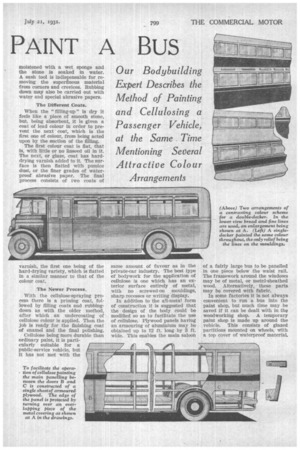HOW TO
Page 64

Page 65

If you've noticed an error in this article please click here to report it so we can fix it.
PAINT A BUS pAINTING fulfils two purposes, because it protects the panels and other surfaces from the weather, as well as being a means for embellishment. Taking, first, the less important aspect, the choice of a decorative scheme includes not only a selection of the colours to be used, but also their arrangement. The simplest scheme consists of the use of the same colour throughout, this being relieved only by fine or broad lines on the mouldings and other prominent parts, by the writing display and bright metalwork.
Another plan is to utilize two most vivid one used. Brilliant hues give prominence to a vehicle, but such colours do not form an ideal groundwork for writing display. On the other hand, quiet or pastel shades do not show mud and dust readily.
Although the ordinary painting and cellulose processes differ an ochre or silica base ground in turpentine mixed with gold size and hard-drying varnish.
Aiding Rubbing Down.
Three or four filling coats are brushed on and each is allowed to dry before the next one is applied. The last coat of filling may be darker than the others, or a special straining c6at may he added. In each case the darker colour acts as a guide to the painter during the process of rubbing down, because he can see at a glance which parts have been fully rubbed.
Rubbing down is done with artificial pumice stone. The panels are varnish, the first one being of the hard-drying variety, which is flatted in a similar manner to that of the colour coat.
The Newer Process, With the cellulose-spraying process there is a priming coat, followed by filling coats and rubbingdown as with the older method, after which an undercoating of cellulose colour is applied. Then the job is ready for the finishing coat of enamel and the final polishing.
Cellulose being more durable than ordinary paint, it is particularly suitable for a public-service vehicle, but it has not met with the same amount of favour as in the private-car industry. The best type of bodywork for the application of cellulose is one which has an exterior surface entirely of metal, with no screwed-on mouldings, sharp recesses or writing display.
In addition to the all-metal form of construction if is suggested that the design of the body could be modified so as to facilitate the use of cellulose. Plywood panels having an armouring of aluminium may be obtained up to 12 ft. long by 3 ft. wide. This enables the main saloon
of a fairly large bus to be panelled in one piece below the waist rail. The framework around the windows may be of metal, or metal-sheathed wood. Alternatively, these parts may be covered with fabric.
In some factories it is not always convenient to rim a bus into the paint shop, but much time may be saved if it can be dealt with in the woodworking shop. A temporary paint shop is made up around the vehicle. This consists of glazed partitions mounted on wheels, with a top cover of waterproof material.




































































































